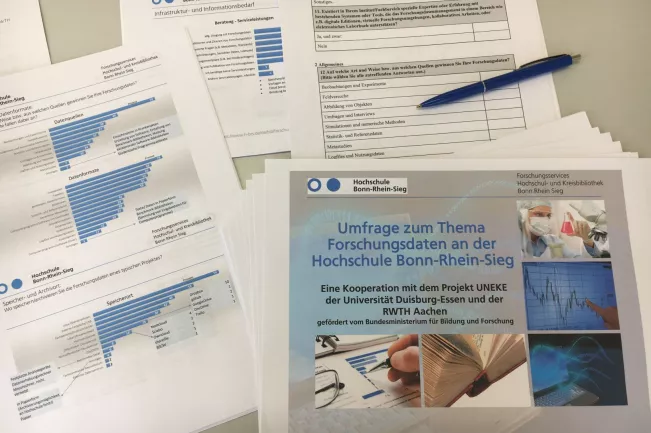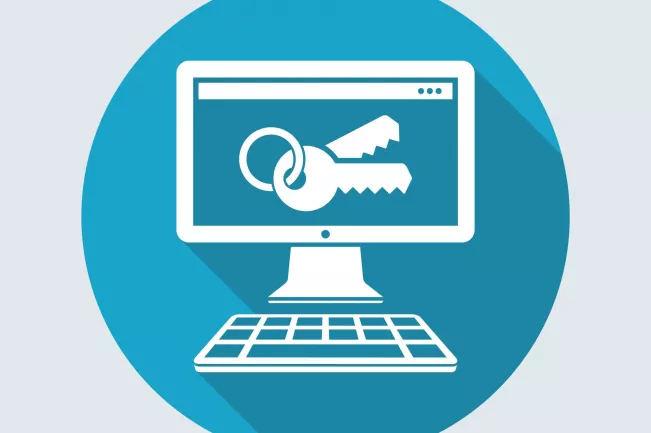University and District Library
Increasing digitisation in research
by Dr Susanne Buch

In the past, a drawing of the object seen through the microscope had to be made with great effort by hand. Nowadays, a digital photo can be generated at the click of a mouse and stored directly on the computer.
With the increasing shift from paper to electronic media, the scientific world is undergoing a change that poses new problems for researchers. In order to be able to support the staff of the H-BRS in this process, it is important to understand their current handling of digital data. Therefore, in cooperation with the UNEKE project of the University of Duisburg-Essen and the RWTH Aachen University, a survey on research data was conducted at our university.
Project UNEKE
In a joint project, the University of Duisburg-Essen and RWTH Aachen University have set themselves the goal of evaluating the handling of research data at German universities and using the data collected to draw up a roadmap for research data infrastructures. (UNEKE: Vom USB-Stick zur NFDI – Entwicklung eines kriteriengeleiteten Entscheidungsmodells für den Aufbau von Forschungsdateninfrastrukturen)
In the course of the project, a survey on research data was conducted in 2018 at 13 universities in NRW and the surrounding area. One of the aims was to provide the universities with assistance in determining their needs. At the same time, an overview of the status of research data management in our university landscape was also to be provided.

The Survey
Thanks to good participation, the results of the survey are relevant for assessing the current handling of research data at the H-BRS. It was shown that many of the researchers are very conscious of how they handle the data they collect. More than half of the participants came from the natural sciences. However, the disciplines of engineering sciences, humanities and social sciences and life sciences were also represented.

Saving and Archiving
The scientifically generated data appear in a wide variety of formats and sizes, from a few kilobytes to one terabyte per research project. According to the researchers, these files are also kept for a long time; up to 50% of the data are stored for more than 25 years. Thus, over the next few years, more and more data will accumulate, for which sufficiently secure storage space must also be provided.
The location of storage and archiving at the H-BRS is usually local, either on the business computer or on USB devices. To a lesser extent, the offered institute and university servers are used. A significant proportion store research data on private laptops. Various cloud services are also used, while external repositories and archiving services are hardly ever used. It is important to mention here that server solutions are clearly better suited for the secure storage of research data, as local devices can be lost or become defective.
The participants were also asked how they structure their research data with additional information. Information necessary for the retrieval of research data, so-called metadata, is stored at the university in 74% of cases - in half of the cases, however, no scheme is used for this purpose. If the file information is not traceable, there is unfortunately the threat of classification as scrap data.
Sustainability is also a concept in the field of research data. So you should think carefully about the formats in which you store files. Manufacturer-specific formats are not supported forever, so for long-term archiving we recommend more general formats such as PDF/A, TXT, CSV, XML, TIFF, etc.

Data protection and Guidelines
The topic of data protection is important to the researchers at H-BRS. About one third of the participants even have to anonymise their data. Access to their own data is often made by other parties, mostly members of their own research group, but also cooperation partners from other universities or from industry. Here, most survey participants would like to have a visible access protocol.
Equally important in research are guidelines of the university and research funding agencies which regulate the handling of the data used. The survey participants would also like to have more information here, as there is a certain amount of uncertainty regarding compliance with the prevailing guidelines.
Infrastructure and Service
Since very few staff are involved in the maintenance of data and data storage in the departments and institutes, there is a great desire for more service offers by the university. These range from sufficient storage space to advice on the handling of research data, the publication of research data, guidelines and information. Last but not least, more legal security is also required with regard to sensitive data and licenses.
Hochschule Bonn-Rhein-Sieg in Comparison
The data obtained in this survey do not differ significantly from the results of the other universities participating in the UNEKE project. However, it should be emphasised that, measured against the rapid progress in the digital world, the infrastructure prevailing at the universities is not fully adequate.
The H-BRS sees it as its mission to create a good working environment for its researchers so that good science can be carried on. For this reason, work is being done in various places to expand the infrastructure to support the handling of digital data.
Throughout the university, researchers are supported with various offers from the central facilities such as a cloud, software, storage space, consulting services and workshops. For example, the Research Services team of the University and District Library advises and trains the researchers of the Bonn-Rhine Sieg University of Applied Sciences on questions of research data management, publications and Open Access.
The awareness that a transformation must take place in the field of research data is supported by numerous projects at the state, national and european level. Currently, the German national research data infrastructure is being formed, funded by the federal and state governments with a funding volume of up to 85 million euros per year.
In the digital transition, we all face exciting times, both positive and negative. The resulting reduction in workload is contrasted by aspects such as security and data protection. The next few years will show whether it will be possible to network research across national borders and thus make a global network of research data freely accessible to everyone.
The detailed results of the survey are available to employees of the Hochschule Bonn-Rhein-Sieg in the intranet: Research Data: Survey Results Report